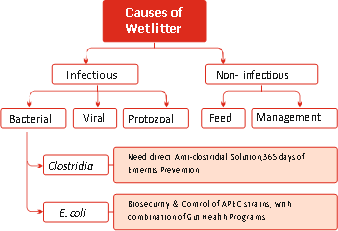Wet dropping provides the producer an invaluable insight into overall gut health of the birds. Wet litter is commonly used to describe nonspecific disease of gastrointestinal and urinary tract. With disease onset, performance problems like increased feed conversion ratio, poor body weight gain, increase in marketing age, predisposition to other secondary bacterial infections and condemnation losses – start precipitating one after other.

Wet litter is associated with altered faecal water content, in short physiological diarrhea. There can be many predisposing factors which causes altered faecal water, affected either by ingesta osmolarity, or reducing the transit time, & reducing absorptive surface area function compromising water absorption and stimulate more intake. (different from the enteritis, with more pathological diarrhea)
Causes of Enteric disorders in poultry – a reason for wet litter
- Infectious
- Bacterial infections caused by E. coli, Salmonella, Clostridium, Campylobacter jejuni and Spirochaetes result in wet litter. The dysbacteriosis may also be induced due to several other factors which upset the usual microbial balance in the intestine.
- Viruses such as REO, IB, IBD, Newcastle Disease virus, Adenovirus, Rota virus, Astro viruses, causes diarrhea. Rotavirus infections cause diarrhea which is the main clinical sign. This is followed by litter eating and inflamed vent. REO viral infections cause mucoid diarrhea with pasty vent. In nephronpathogenic form of Infectious bronchitis viral infections, the water intake will be high and result in diarrhea and wet litter.
- The protozoan parasites causing coccidiosis due to Eimeria species, often cause dysentery and frequent wet litter. Heavy load of internal parasites such as roundworm and tape worm infestation cause diarrhea
- Non Infectious
- Feed. Structure and pellet quality, palatability, formulation and content, mycotoxins With modern breeding and selection procedures, and the resulting high appetite and feed intake the feed passage rate is increased. This is achieved by reduced time spent by ingesta in proventriculus and gizzard. But the retention time in the small intestine remains fairly constant. This reduces the enzyme – nutrient contact, leading to reduced protein digestibility and reduced feed efficiency
- High fiber levels due to higher number of alternate raw materials used.
- The feed ingredient characteristics like particle size, viscosity in solution, starch digestibility and ipid/protein/mineral content.
- Water soluble non starch polysaccharides (NSP) adversely affect digestibility by stimulating mucous production and increasing intestinal viscosity, resulting in wet litter.
- Rancid fats can compromise digestibility and can cause gastrointestinal disturbance and wet litter.
- The ingredients which are rich in high potassium can induce polydipsia, polyuria, and wet litter.
- Nephrotoxins such as Ochratoxin, Citrinin can compromise renal function cause polyuria/ polydipsia.
- High intake of certain minerals – Potassium, Sodium, Magnesium, Sulphate or Chloride
- Excess undigested protein or poor quality feed protein levels in the feed will increase the production of uric acid in the kidneys, lead to wet droppings. This will lead to contact dermatitis.
- Folic acid deficiency causes diarrhea.
- Birds that are placed on a restricted feeding program, consume much more water than usual.
- Management. Available feed space, water space, distribution of feeders, drinkers, air quality, ventilation, litter, temperature, and density.
- High temperature & high humidity
- Foggers – with low-pressure systems and large particle sizes can cause wet litter if poultry house humidity is high
- Wet litter problems occur quite easily in overcrowded houses. It is important that adequate feed and water space be provided in hot climates and additional drinkers be used during the very hot periods of the year.
Impact of wet litter – Economic & Performance
- Ammonia – Respiratory disease, Poor weight gains due to nutrient loss poor FCR & weight Gain.
- Disease – Mortality, Morbidity, and medication costs
- Parasites – Anticoccidial drugs, De-wormers
- Condemnation and downgrades – Breast blisters,transport loss, dirty eggs in layers & breeders
Ultimately, we need to ensure the better gut health of our broilers to have a superior performance in terms of broiler meat production at an optimum production cost.

“Sub-clinial, clinical Clostridium infection related economic impact is about 2-4 point FCR or about 40-80 g body weight per bird”